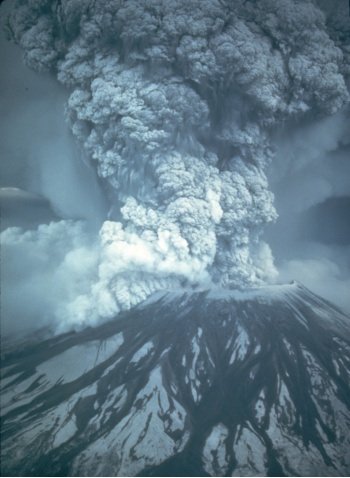
Publisher:
Bonnie King
CONTACT:
Newsroom@Salem-news.com
Advertising:
Adsales@Salem-news.com

~Truth~
~Justice~
~Peace~
TJP
Feb-21-2007 11:13

 TweetFollow @OregonNews
TweetFollow @OregonNews
Oregon State Study Finds Gas Movement Key to Mount St. Helens Eruptions
Salem-News.comIn September of 2004, Mount St. Helens had some of its first significant explosions and dome building since 1986.
 Mount St. Helens erupted May 18th, 1980. Photo: vulcan.wr.usgs.gov |
(CORVALLIS) - A study being published this week suggests that gas and vapor movement to the top of the magma body may have caused fairly rapid increases in pressure and could have been the triggering mechanism that caused Mount St. Helens to erupt in both 1980 and 2004.
Researchers used analysis of the trace element lithium to reach these conclusions, finding that crystals in the erupting lava were highly enriched with lithium in the first few weeks after each eruption, but then levels dropped back to a normal range.
This suggests, they said, that lithium diffused into rising bubbles and added to a gas-rich pocket that formed just in the months preceding the eruption.
The study was just published in Geology, a professional journal, by scientists from Oregon State University, the U.S. Geological Survey, and five other universities.
“An explosive volcano may be a little like a shaken-up pop bottle,” said Adam Kent, an OSU assistant professor of geosciences. “This research suggests that gases move to the top of magma chambers under volcanoes, where they can help break through the overlying crust and cause an eruption. This is leading us to a better understanding of how volcanoes behave and what the potential triggers are.”
The findings, Kent said, do not yet have great predictive value -- for one thing, researchers have no way of getting into the hot magma under a live volcano to check its gas levels.
But when an eruption first begins, analysis of its rock samples and how enriched they are in lithium and other volatile gases may help provide clues to the nature and possible severity of the event.
In September of 2004, Mount St. Helens had some of its first significant explosions and dome building since 1986.
There had been numerous smaller eruptions in the six years following the cataclysmic explosion of May, 1980.
After it became active again in 2004, large amounts of lava poured out -- 81 million cubic meters by last spring.
The eruptive phase has been vigorous, pouring forth about as much lava as all the previous dome-building eruptions of the 1980s in about half the time. It’s continuing and could go on for years, Kent said.
The newest findings were made possible by some “helicopter dredging” done by the U.S. Geological Survey, scooping up material coming out after the 2004 eruption.
A laser technique called “inductively coupled plasma mass spectrometry” allowed scientists to determine element concentrations at parts per million, and the one thing that stood out was the high level of lithium immediately following the first eruption.
“We still don’t know exactly what causes a volcano to erupt, especially when they have been quiet for a long time,” Kent said. “Increases in gas pressure have been one of the suspected causes, but it is often difficult to prove this.
“What this study indicates is that in the months prior to an eruption, there was in fact a rapid increase in vapor pressure in the magma stored under the volcano,” he said. “The lithium, which is soluble as a vapor and very mobile, rose rapidly along with other gases just prior to the eruption.”
As a technique for future use, Kent said, erupting rocks that are high in volatile elements such as lithium may be a clue that gas levels are high and the eruption could be more intense and continuing.
This process may be fairly common to other explosive volcanoes around the world, he said.
Other collaborators on the study included Michael C. Rowe from OSU, and researchers from the University of Bristol, University of Oregon, University of California/Davis, University of Washington, and University of Iowa.
The study was funded by the National Science Foundation.
Articles for February 20, 2007 | Articles for February 21, 2007 | Articles for February 22, 2007

Salem-News.com:


Quick Links
DINING
Willamette UniversityGoudy Commons Cafe
Dine on the Queen
Willamette Queen Sternwheeler
MUST SEE SALEM
Oregon Capitol ToursCapitol History Gateway
Willamette River Ride
Willamette Queen Sternwheeler
Historic Home Tours:
Deepwood Museum
The Bush House
Gaiety Hollow Garden
AUCTIONS - APPRAISALS
Auction Masters & AppraisalsCONSTRUCTION SERVICES
Roofing and ContractingSheridan, Ore.
ONLINE SHOPPING
Special Occasion DressesAdvertise with Salem-News
Contact:AdSales@Salem-News.com

Terms of Service | Privacy Policy
All comments and messages are approved by people and self promotional links or unacceptable comments are denied.
alyssa March 18, 2010 10:32 am (Pacific time)
im human because i have a hand
ramiara April 28, 2009 8:52 am (Pacific time)
this is graet setion for litile chrildren likme
Brianna April 7, 2009 4:24 am (Pacific time)
Woah! I just think what nature does is amazing and a volcanic explosion is one of those great wonders...
IDK February 2, 2009 12:34 pm (Pacific time)
yooooouuuuu arrrreeeee soooooooo wwwwwweeeeeeeeiiiiiiiirrrrrrrrrddddddddddddd ! :L
Anonymous January 21, 2009 11:53 am (Pacific time)
yooooouuuuu arrrreeeee soooooooo wwwwwweeeeeeeeiiiiiiiirrrrrrrrrddddddddddddd ! :L
L.C. Cane February 22, 2007 12:55 am (Pacific time)
I saw Mt St Helens when it blew in '80, and it's one of those incredible moments. I wouldn't want to be too close though, if it happened again. I think we should try to figure out what the catalysts are... or we'll have more Harry Truman's in our future! (If you weren't here, you won't get it)
[Return to Top]©2025 Salem-News.com. All opinions expressed in this article are those of the author and do not necessarily reflect those of Salem-News.com.